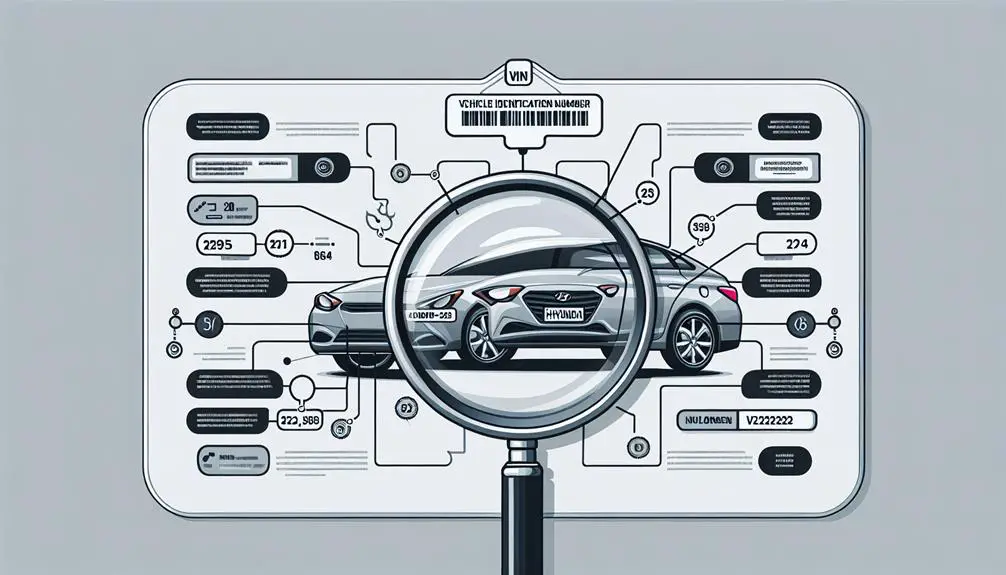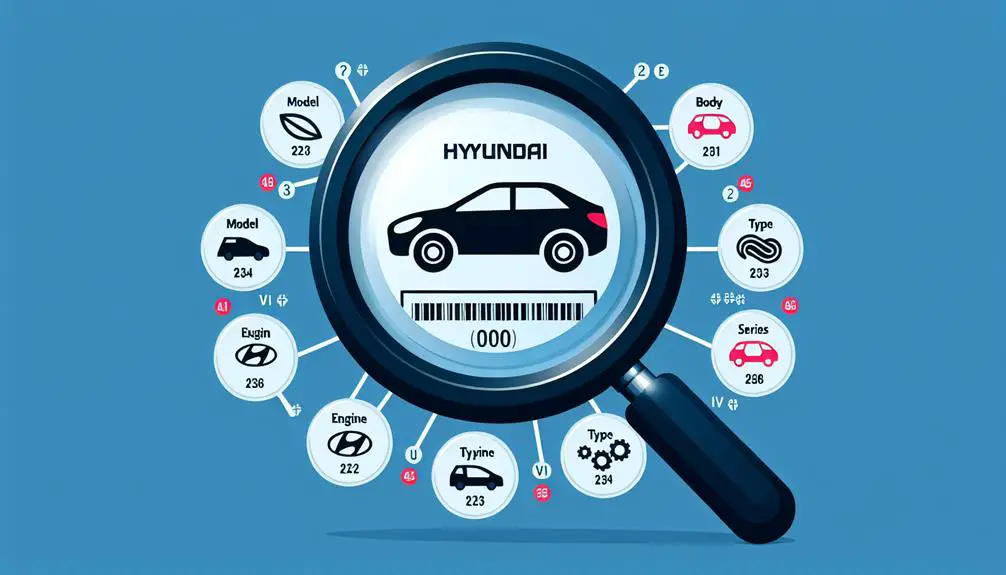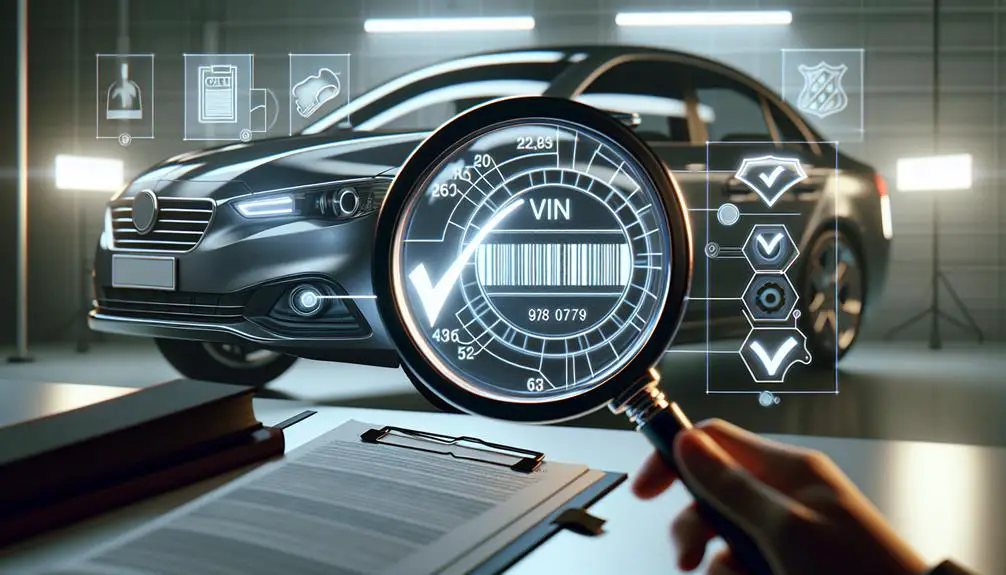To read a Hyundai VIN number, you need to understand its structure and interpret its codes. This process will reveal the vehicle's identity, history, and authenticity, including its manufacture country, specific features, and production number.
Learning to read the VIN is crucial for informed decisions regarding car purchases or understanding more about your vehicle.
Understanding the VIN Structure

To fully grasp your Hyundai's identity, it's vital to comprehend the unique 17-character VIN structure. This isn't just a random string of numbers and letters; it's a detailed code that reveals your vehicle's story, from its origin to its specifications.
After the initial three characters, which we'll skip over for now, the VIN delves deeper into your car's identity. Characters 4 through 8 are particularly revealing, as they disclose the vehicle's model, body type, engine size, and series. This segment is crucial for understanding what's under the hood and the car's design. The 9th character, though often overlooked, serves as a check digit to validate the VIN's authenticity—a safeguard against fraud.
Moving on, the 10th character reveals the model year of your Hyundai with a single letter or number. This is vital for knowing your car's age without needing any other documents. Characters 11 through 17 are the sequential production number, showing your Hyundai's place in the production line. This helps pinpoint when your car was made, offering a glimpse into its manufacturing context.
Comprehending each segment of the VIN allows you to reveal valuable insights about your Hyundai, ensuring you're fully informed about your vehicle's essence and history.
Decoding the First Three Characters
Now, let's investigate the initial three characters of your Hyundai's VIN, which expose where your vehicle was produced. These characters, collectively known as the World Manufacturer Identifier (WMI), are important for identifying the country of origin and the manufacturer.
The beginning character specifies the country where your Hyundai was manufactured. For instance, a VIN starting with 'K' indicates that your vehicle was made in Korea. If it starts with a '3', your Hyundai was produced in Mexico. This starting letter or number is a quick way to pinpoint the geographical origin of your car.
Moving on to the next character, it represents Hyundai as the manufacturer. Typically, you'll find 'M' standing in for Hyundai, confirming that your vehicle is indeed a product of this renowned automaker.
The third character delves a bit deeper, giving insight into the vehicle type or manufacturing division. This could refer to the specific Hyundai plant where your car was assembled or the category of vehicle, such as passenger car, SUV, or commercial vehicle.
Together, these initial three characters provide a snapshot of your Hyundai's roots, highlighting not just the where but also the who behind your vehicle's production.
Interpreting the Vehicle Descriptor Section

After decoding the World Manufacturer Identifier, you'll examine the Vehicle Descriptor Section, which offers critical details about your Hyundai's specifications and features. This part of the VIN provides invaluable information about your vehicle's model, body type, engine size, and more. By comprehending this section, you can uncover specifics that are important whether you're buying a used car, ordering parts, or simply want to know more about your vehicle.
When interpreting the Vehicle Descriptor Section, keep in mind:
- Model Type: This tells you the exact model of your Hyundai, distinguishing between variations in the same lineup.
- Body Type: Learn whether your car is a sedan, SUV, hatchback, etc., which is crucial for body part replacements.
- Engine Code: Identifies the engine size and type. This is important for maintenance, repairs, and comprehending your vehicle's performance capabilities.
- Restraint System Type: Information about the safety features installed, such as airbags and seatbelts, providing insight into the vehicle's safety standards.
Does the Specific Starting Number of a Hyundai Vin Number Have any Significance in Reading it?
When it comes to Hyundai VIN numbers explanation, the specific starting number does hold significance. This number, known as the World Manufacturer Identifier, identifies the country of origin and the manufacturer. For Hyundai vehicles, this number usually starts with a K, indicating that it was manufactured in Korea.
Analyzing the Vehicle Identifier Section
Having investigated the Vehicle Descriptor Section, let's concentrate on analyzing the Vehicle Identifier Section, where you'll uncover the production details of your Hyundai.
This section, positioned at the end of your VIN, specifically the last six to eight characters, holds key information about your vehicle's production sequence. Unlike the earlier parts of the VIN, which detail the model, engine type, and manufacturing location, this section zeros in on your car's unique identity within its production series.
Here's what you need to know: the sequence of numbers isn't random. It represents the order in which your Hyundai rolled off the assembly line. This can be particularly useful if you're trying to determine how rare your model might be, based on production volumes. For instance, a lower sequence number could indicate an early production model, possibly making it more unique.
Checking for Authenticity and History

Once you've decoded your Hyundai's VIN, it's vital to verify the vehicle's authenticity and investigate its history. This step is critical for ensuring you're not buying a lemon or a car with a hidden past. Here's how you can delve further into your Hyundai's backstory and guarantee its legitimacy:
- Check for Stolen Reports: Use the VIN to search national databases for any reports of the car being stolen. This is an important step to make sure you're not inadvertently buying stolen property.
- Verify with Hyundai: Contact Hyundai directly or visit their website with your VIN handy. They can provide you with verification services to make sure the vehicle matches their records.
- Get a Vehicle History Report: Websites like Carfax or AutoCheck allow you to enter the VIN and receive a detailed report of the vehicle's history, including any accidents, service records, and previous ownership.
- Inspect for Tampering: Visually inspect the VIN on the car at different locations. Make sure it hasn't been tampered with or altered, which could indicate fraudulent activity.
Conclusion
Now that you've delved into the intricacies of your Hyundai's VIN, you're equipped to decipher its identity.
From grasping the global language of the initial three characters to dissecting the vehicle descriptor and identifier sections, you've peeled back layers revealing its origins, specifications, and unique identity.
Always check for authenticity and history to make sure you're not overlooking crucial details.
You're now more connected to your vehicle, armed with knowledge to make informed decisions and conversations about your Hyundai.